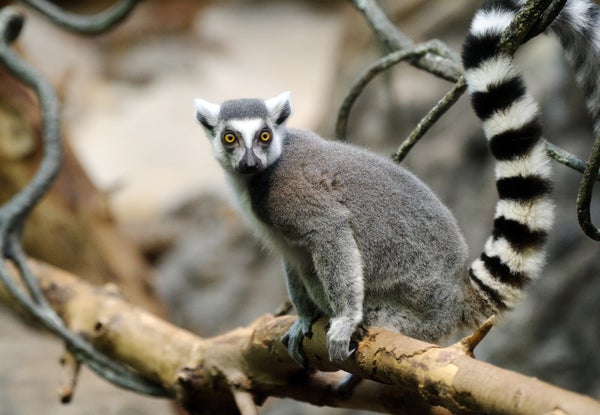This article was published in Scientific American’s former blog network and reflects the views of the author, not necessarily those of Scientific American
Madagascar’s beloved ring-tailed lemurs (Lemur catta) have all but disappeared from many of the island nation’s forests. According to two worrying new studies, the species’ population has fallen to between 2,000 and 2,400 animals—a shocking 95 percent decrease since the year 2000.
To put that number in context, there are now fewer ring-tailed lemurs living in the wild than there are living in zoos around the world.
Factors driving the decline include rapid habitat loss, hunting, and the illegal pet trade, according to a paper published last month in the journal Primate Conservation and a second paper published today in Folia Primatologica.
On supporting science journalism
If you're enjoying this article, consider supporting our award-winning journalism by subscribing. By purchasing a subscription you are helping to ensure the future of impactful stories about the discoveries and ideas shaping our world today.
The situation is so bad that many ring-tailed lemur sub-populations now contain fewer than 30 individuals. In addition, the animals have completely disappeared from at least 15 sites they once called home.
The now-empty forests are “very sad, quiet and dusty,” says Marni LaFleur, lead author of the second paper and a co-director of the conservation organization Lemur Love. “There was a thick layer of crunchy leaf litter on the ground, and dust on top. Some trees were heavy with ripe and rotten fruits. Without birds or mammals to consume them, the untouched fruits just rot in and around the trees. Normal aspects of a forest, which as a biologist I have a fairly keen eye for—footprints, scat, bite marks, sleeping spots, calls—are absent.”
Some forests were so empty, LaFleur says, that even the hunters have abandoned them. “We also saw half a dozen makeshift meat-drying racks,” she says. “These, too, were dusty and now unused. There is nothing left to hunt.”
Previous studies have started to document aspects of the ring-tailed lemur’s decline, but the full scope of the results of the new surveys still proved shocking for the researchers. “We certainly didn't expect to find such a dramatic population decrease,” says another of the paper’s authors, Tara A. Clarke, also a co-director of Lemur Love. “As we were in the field and started visiting ring-tailed lemur sites or areas where they had been known to range historically and started combing the literature for the most recent estimates, we started to realize how severe the situation was for this species and we became extremely concerned.”
As a result of this research, Clarke says ring-tailed lemurs will be included in the next edition of the biennial list of the world’s 25 most endangered primates, due out later this year. (The 2015 edition, which includes five other lemur species, can be found here.)
The full extent of the ring-tailed lemur’s decline went unnoticed for so long because few people currently study the species on a regular basis. “The two most prolific researchers, Alison Jolly and Robert Sussman, have died and we are the only descendants with active research in Madagascar,” Clarke says. “Research presence is very important to long-term survival of species, and the lemurs just don’t have that at the moment,” she added.
Stopping this decline will present numerous challenges. “At the moment, we’re seeing ongoing illegal extraction of lemurs from the wild in Madagascar for the pet trade and hunting,” said a third of the paper’s authors, Dr. Kim Reuter of Conservation International in a prepared statement. “This issue is currently not being regulated, and is sometimes even done in the open. Even when lemurs are confiscated from illegal owners, there are just a handful of facilities in the country that can take individuals in for rehabilitation.”
The situation can change, but only, the researchers say, if conservation efforts are tied to social and economic development within Madagascar. LaFleur says a great example already starting to make a difference is an IUCN Initiative called Save Our Species (SOS) Lemurs, which “has had very good results in bringing together researchers and conservationists with local communities to build better futures for all parties— lemurs included.” Lemur Love, meanwhile, is actively seeking partnerships with zoos in order to increase their own conservation impact.
Can things turn around for this species? “If hunting, habitat loss, and capture for the illegal pet trade were to stop and concentrated conservation initiatives were to take place there is a great chance that this species would rebound,” says Clarke. “Efforts should be concentrated on the remaining larger populations, such as Berenty, Isalo, and Tsimanampesotse, and of course if there are opportunities to build forest corridors in particular areas that would be extremely important for maintaining the genetic diversity of these wild populations.” Unlike many other lemur species, ring-tailed lemurs can give birth every year, so populations could grow fairly quickly, although Clarke points out that infant mortality is high even under the best conditions.
In addition to their possible reproductive advantage, ring-tailed lemurs are generalists which can survive in a wide range of habitats—as long as those habitats continue to exist. “They can live in a plethora of habitat types and have highly diverse and varied diets,” says LaFleur. “They are survivors. But, as we’ve seen first-hand, there is only so much they can bounce back from.”
Previously in Extinction Countdown:
